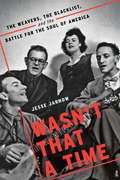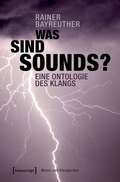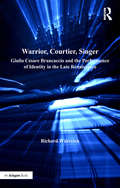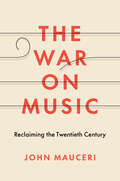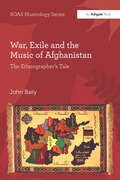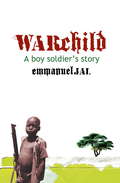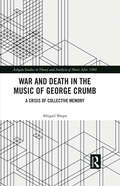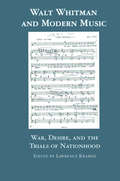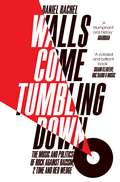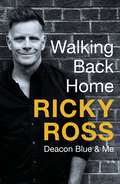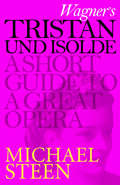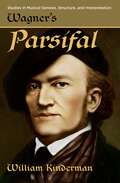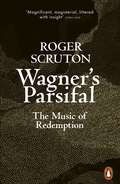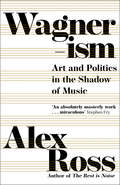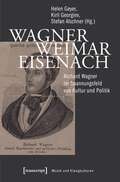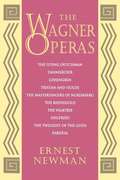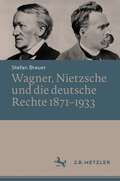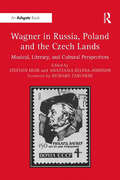- Table View
- List View
Wasn't That a Time: The Weavers, the Blacklist, and the Battle for the Soul of America
by Jesse JarnowThe dramatic untold story of the Weavers, the hit-making folk-pop quartet destroyed with the aid of the United States government -- and who changed the world, anyway Following a series of top-ten hits that became instant American standards, the Weavers dissolved at the height of their fame. Wasn't That a Time: The Weavers, the Blacklist, and the Battle for the Soul of America details the remarkable rise of Pete Seeger's unlikely band of folk heroes, from basement hootenannies to the top of the charts, and the harassment campaign that brought them down. Exploring how a pop group's harmonies might be heard as a threat worthy of decades of investigation by the FBI, Wasn't That a Time turns the black-and-white 1950s into vivid color, using the Weavers to illuminate a dark and complex period of American history. With origins in the radical folk collective the Almanac Singers and the ambitious People's Songs, the singing activists in the Weavers set out to change the world with songs as their weapons, pioneering the use of music as a transformative political organizing tool. Using previously unseen journals and letters, unreleased recordings, once-secret government documents, and other archival research, Jesse Jarnow uncovers the immense hopes, incredible pressures, and daily struggles of the four distinct and often unharmonious personalities at the heart of the Weavers. In an era defined by a sharp political divide that feels all too familiar, the Weavers became heroes. With a class -- and race -- conscious global vision that now makes them seem like time travelers from the twenty-first century, the Weavers became a direct influence on a generation of musicians and listeners, teaching the power of eclectic songs and joyous, participatory harmonies.
Was sind Sounds?: Eine Ontologie des Klangs (Musik und Klangkultur #36)
by Rainer BayreutherWas sichtbare oder tastbare Dinge sind, weiß jede_r. Was aber sind hörbare Dinge? Die Klangquelle, die Luftschwingung oder die Klänge selber? Und welche Eigenschaften haben diese Dinge? In diesem Grundlagenwerk für Sound Studies und Musikwissenschaft, für das Kartographieren von Geräuschen sowie für Klangfetischisten, entwickelt Rainer Bayreuther in einer klaren ontologischen Systematik die Individualität sowie die Eigenschaften von Klängen. Die Arbeit wird anhand zahlreicher Fallbeispiele veranschaulicht.
Warum Musik in unseren Genen liegt
by Jörn Bullerdiek Christine SüßmuthWussten Sie, warum Johann Sebastian Bach ganz legal lange Finger machte? Und was Sie alles mit einer Haarlocke Mozarts anfangen könnten, wenn Sie sie besäßen? Beides könnte Sie auf die Spur eines uralten Geheimnisses bringen, nämlich warum Menschen Freude am „Hervorbringen musikalischer Töne“ haben, wie Darwin es formulierte. Liegt das wortwörtlich in unserer DNA und was hat es dort zu suchen? Die Autoren sind in gefährlicher Nähe am Felsen der Sirenen vorbei gesegelt und haben Orpheus in die Unterwelt begleitet. Sie haben den Weg von Schallwellen von ihrer Quelle bis zum Gehirn der Hörenden verfolgt und ebenso den Stammbaum der Familie Bach wie den Gesang von Zebrafinken analysiert. Schließlich sind sie nicht nur in den Sonderzug nach Pankow gestiegen, sondern haben auch noch die Caprifischer in ihrer Heimat aufgesucht. Alles in allem ist eine unterhaltsame und informative Analyse dessen entstanden, was vom alten Ägypten bis in heutige Zeit die Faszination von Musik im Spiegel unserer Gene ausmacht.
Warrior, Courtier, Singer: Giulio Cesare Brancaccio and the Performance of Identity in the Late Renaissance
by Richard WistreichGiulio Cesare Brancaccio was a Neapolitan nobleman with long practical experience of military life, first in the service of Charles V and later as both soldier and courtier in France and then at the court of Alfonso II d'Este at Ferrara. He was also a virtuoso bass singer whose performances were praised by both Tasso and Guarini - he was even for a while the only male member of the famous Ferrarese court Concerto delle dame, who established a legendary reputation during the 1580s. Richard Wistreich examines Brancaccio's life in detail and from this it becomes possible to consider the mental and social world of a warrior and courtier with musical skills in a broader context. A wide-ranging study of bass singing in sixteenth- and early seventeenth-century Italy provides a contextual basis from which to consider Brancaccio's reputation as a performer. Wistreich illustrates the use of music in the process of 'self-fashioning' and the role of performance of all kinds in the construction of male noble identity within court culture, including the nature and currency of honour, chivalric virtù and sixteenth-century notions of gender and virility in relation to musical performance. This fascinating examination of Brancaccio's social world significantly expands our understanding of noble culture in both France and Italy during the sixteenth century, and the place of music-making within it.
Warrior, Courtier, Singer: Giulio Cesare Brancaccio and the Performance of Identity in the Late Renaissance
by Richard WistreichGiulio Cesare Brancaccio was a Neapolitan nobleman with long practical experience of military life, first in the service of Charles V and later as both soldier and courtier in France and then at the court of Alfonso II d'Este at Ferrara. He was also a virtuoso bass singer whose performances were praised by both Tasso and Guarini - he was even for a while the only male member of the famous Ferrarese court Concerto delle dame, who established a legendary reputation during the 1580s. Richard Wistreich examines Brancaccio's life in detail and from this it becomes possible to consider the mental and social world of a warrior and courtier with musical skills in a broader context. A wide-ranging study of bass singing in sixteenth- and early seventeenth-century Italy provides a contextual basis from which to consider Brancaccio's reputation as a performer. Wistreich illustrates the use of music in the process of 'self-fashioning' and the role of performance of all kinds in the construction of male noble identity within court culture, including the nature and currency of honour, chivalric virtù and sixteenth-century notions of gender and virility in relation to musical performance. This fascinating examination of Brancaccio's social world significantly expands our understanding of noble culture in both France and Italy during the sixteenth century, and the place of music-making within it.
The War on Music: Reclaiming the Twentieth Century
by John MauceriA prominent conductor explores how aesthetic criteria masked the political goals of countries during the three great wars of the past century This book offers a major reassessment of classical music in the twentieth century. John Mauceri argues that the history of music during this span was shaped by three major wars of that century: World War I, World War II, and the Cold War. Probing why so few works have been added to the canon since 1930, Mauceri examines the trajectories of great composers who, following World War I, created voices that were unique and versatile, but superficially simpler. He contends that the fate of composers during World War II is inextricably linked to the political goals of their respective governments, resulting in the silencing of experimental music in Germany, Italy, and Russia; the exodus of composers to America; and the sudden return of experimental music—what he calls “the institutional avant-garde”—as the lingua franca of classical music in the West during the Cold War.
War, Exile and the Music of Afghanistan: The Ethnographer’s Tale (SOAS Studies in Music)
by John BailyIn the 1970s John Baily conducted extensive ethnomusicological research in Afghanistan, principally in the city of Herat but also in Kabul. Then, with Taraki’s coup in 1978, came conflict, war, and the dispersal of many musicians to locations far and wide. This new publication is the culmination of Baily’s further research on Afghan music over the 35 years that followed. This took him to Afghanistan, Pakistan, Iran, the USA, Australia and parts of Europe - London, Hamburg and Dublin. Arranged chronologically, the narrative traces the sequence of political events - from 1978, through the Soviet invasion, to the coming of the Taliban and, finally, the aftermath of the US-led invasion in 2001. He examines the effects of the ever-changing situation on the lives and works of Afghan musicians, following individual musicians in fascinating detail. At the heart of his analysis are privileged vignettes of ten musical personalities - some of friends, and some newly discovered. The result is a remarkable personal memoir by an eminent ethnomusicologist known for his deep commitment to Afghanistan, Afghan musicians and Afghan musical culture. John Baily is also an ethnographic filmmaker. Four of his films relating to his research are included on the downloadable resources that accompanies the text.
War, Exile and the Music of Afghanistan: The Ethnographer’s Tale (SOAS Studies in Music)
by John BailyIn the 1970s John Baily conducted extensive ethnomusicological research in Afghanistan, principally in the city of Herat but also in Kabul. Then, with Taraki’s coup in 1978, came conflict, war, and the dispersal of many musicians to locations far and wide. This new publication is the culmination of Baily’s further research on Afghan music over the 35 years that followed. This took him to Afghanistan, Pakistan, Iran, the USA, Australia and parts of Europe - London, Hamburg and Dublin. Arranged chronologically, the narrative traces the sequence of political events - from 1978, through the Soviet invasion, to the coming of the Taliban and, finally, the aftermath of the US-led invasion in 2001. He examines the effects of the ever-changing situation on the lives and works of Afghan musicians, following individual musicians in fascinating detail. At the heart of his analysis are privileged vignettes of ten musical personalities - some of friends, and some newly discovered. The result is a remarkable personal memoir by an eminent ethnomusicologist known for his deep commitment to Afghanistan, Afghan musicians and Afghan musical culture. John Baily is also an ethnographic filmmaker. Four of his films relating to his research are included on the downloadable resources that accompanies the text.
War Child: A Boy Soldier's Story
by Emmanuel JalEmmanuel Jal was only seven years old when he was taken from his family home to become a child soldier with the rebel army in Sudan's bloody civil war for nearly five years. Beaten, starved and brutalised Emmanuel was put into battle in Ethiopia and southern Sudan carrying an AK-47 talller than himself.He attempted to leave the SPLA but was hunted down and thrown into a desert prison. He finally escaped and is now an internationally-acclaimed rap artist spreading messages of peace and reconciliation with his unique style of gospel rap.
War and Death in the Music of George Crumb: A Crisis of Collective Memory (Ashgate Studies in Theory and Analysis of Music After 1900)
by Abigail ShupeThis book studies George Crumb’s The Winds of Destiny (2004) and Black Angels (1970) as artifacts of collective memory and cultural trauma. It situates these two pieces in Crumb’s output and unpacks the complex methodologies needed to understand these pieces as contributions and challenges to traditional narratives of the Civil War and the Vietnam War. The Winds of Destiny is shown to be a critical commentary on the legacy of American wars and militarism, both concepts crucial to American identity. The Winds of Destiny also acts as an ironic war memorial as a means of critiquing such concepts. Black Angels has long been associated with the Vietnam War. This book shows how this association began and how it endures through connections to iconic Vietnam War media, including films and books. Together these analyses show the legacy of trauma in American collective memory, which is in a continuous crisis. Crumb’s musical critiques point to a need to resist conventional narratives and to begin to heal trauma on a collective level. This book will be of interest to students of contemporary American music, American studies, and memory studies. It benefits readers by newly situating Crumb’s music within these three fields of study.
War and Death in the Music of George Crumb: A Crisis of Collective Memory (Ashgate Studies in Theory and Analysis of Music After 1900)
by Abigail ShupeThis book studies George Crumb’s The Winds of Destiny (2004) and Black Angels (1970) as artifacts of collective memory and cultural trauma. It situates these two pieces in Crumb’s output and unpacks the complex methodologies needed to understand these pieces as contributions and challenges to traditional narratives of the Civil War and the Vietnam War. The Winds of Destiny is shown to be a critical commentary on the legacy of American wars and militarism, both concepts crucial to American identity. The Winds of Destiny also acts as an ironic war memorial as a means of critiquing such concepts. Black Angels has long been associated with the Vietnam War. This book shows how this association began and how it endures through connections to iconic Vietnam War media, including films and books. Together these analyses show the legacy of trauma in American collective memory, which is in a continuous crisis. Crumb’s musical critiques point to a need to resist conventional narratives and to begin to heal trauma on a collective level. This book will be of interest to students of contemporary American music, American studies, and memory studies. It benefits readers by newly situating Crumb’s music within these three fields of study.
The Wanted: The Unauthorized Biography
by Chas Newkey-BurdenMax George, Siva Kaneswaran, Tom Parker, Nathan Sykes and James McGuiness topped the UK charts within a week of the release of their first single 'All Time Low'. With two number one hits under their belts, as well as polished performances and cheeky group camaraderie, The Wanted are synonymous with young, cool and successful. After facing gruelling mass-auditions to be part of the band, the five boys moved into a flat together in London, where they quickly developed a strong bond. Now perfecting their third studio album, featuring collaborations with Dappy, Chris Brown and Rita Ora this is The Wanted's most ambitious project yet. With worldwide fame now so firmly in their sights, this uber cool boyband has taken the charts by storm - and has won the hearts of millions of fans in the process. The amazing and inspirational story of how The Wanted have risen to stardom, as well as fascinating details about each of the boys and their backgrounds, is set to be a gripping reading for their growing number of fans.
Walt Whitman and Modern Music: War, Desire, and the Trials of Nationhood (Border Crossings)
by Lawrence KramerWalt Whitman's poetry, especially his Civil War poetry, attracted settings by a wide variety of modern composers in both English- and German-speaking countries. The essays in this volume trace the transformation of Whitman's nineteenth-century texts into vehicles for confronting twentieth-century problems-aesthetic, social, and political. The contributors pay careful attention to music and poetry alike in examining how the Whitman settings become exemplary means of dealing with both the tragic and utopian faces of modernism. The book is accompanied by a CD recording by Joan Heller and Thomas Stumpf of complete Whitman cycles composed by Kurt Weill, George Crumb, and Lawrence Kramer, and the first recording of four Whitman songs composed in the 1920s by Marc Blitzstein.
Walt Whitman and Modern Music: War, Desire, and the Trials of Nationhood (Border Crossings)
by Lawrence KramerWalt Whitman's poetry, especially his Civil War poetry, attracted settings by a wide variety of modern composers in both English- and German-speaking countries. The essays in this volume trace the transformation of Whitman's nineteenth-century texts into vehicles for confronting twentieth-century problems-aesthetic, social, and political. The contributors pay careful attention to music and poetry alike in examining how the Whitman settings become exemplary means of dealing with both the tragic and utopian faces of modernism. The book is accompanied by a CD recording by Joan Heller and Thomas Stumpf of complete Whitman cycles composed by Kurt Weill, George Crumb, and Lawrence Kramer, and the first recording of four Whitman songs composed in the 1920s by Marc Blitzstein.
Walls Come Tumbling Down: The Music and Politics of Rock Against Racism, 2 Tone and Red Wedge
by Daniel RachelWalls Come Tumbling Down charts the pivotal period between 1976 and 1992 that saw politics and pop music come together for the first time in Britain's musical history; musicians and their fans suddenly became instigators of social change, and 'the political persuasion of musicians was as important as the songs they sang'. Through the voices of campaigners, musicians, artists and politicians, Daniel Rachel follows the rise and fall of three key movements of the time: Rock Against Racism, 2 Tone, and Red Wedge, revealing how they all shaped, and were shaped by, the music of a generation.Composed of interviews with over a hundred and fifty of the key players at the time, Walls Come Tumbling Down is a fascinating, polyphonic and authoritative account of those crucial sixteen years in Britain's history.
Walking Back Home
by Ricky Ross'For all these years I've told stories. Sometimes these days I also tell them on the radio. I've met some amazing people and their stories need told too. The first time Deacon Blue ever played Wembley Arena I started to introduce a song only to hear, "Get on with it" shouted from Row Z. We proceeded with the song, but I often thought I'd quite like to finish that story.'In 1986, Ricky Ross started a full-time career in music, which has lasted for over 35 years. His earlier working life was spent in youth work and teaching in his home city of Dundee, and his adopted home of Glasgow. It was in these two cities where he spent his formative years learning how to write and play songs. Having always written about the people and places who've made an impact on his life, it's no surprise that this is how he has approached Walking Back Home, his first ever memoir, which takes the reader on a journey from Ricky's childhood to the rollercoaster of leading his band to top of the charts and their break-up, his solo career and Deacon Blue's recent renaissance.
Wagner's Tristan und Isolde: A Short Guide to a Great Opera (Great Operas)
by Michael SteenWith the ‘Tristan chord’ at the start of Wagner’s opera Tristan und Isolde, the composer launched modern music. The political refugee, a former revolutionary, was living in Zurich when the lovely Mathilde Wesendonck, the wife of a rich businessman, inspired him to break off from working on Siegfried, part of his ‘Ring cycle’, and refocus his efforts on Tristan. Expelled from there, Wagner continued to work on the opera in the Palazzo Giustiniani in Venice, and finished it in Lucerne in 1859. The première, in Munich, was delayed until 1865, after the ‘Mad’ King Ludwig of Bavaria came to Wagner’s financial rescue. Wagner blended Gottfried von Strasburg’s medieval epic with Schopenhauer’s philosophy and his own idiosyncratic views on the psychology and metaphysics of love. (As well, Wagner reflected his views on Greek drama and the integrated Gesamtkunstwerk, or ‘art-work’.) The result is a torrent of sound which depicts almost indecent passion. The Liebestod, in which the sexual love of Tristan and Isolde is consummated through death, and which is often presented in concert performance, is some of the most glorious music ever written. Written by Michael Steen, author of the acclaimed The Lives and Times of the Great Composers, ‘Short Guides to Great Operas’ are concise, entertaining and easy to read. They are packed with useful information and informed opinion, helping to make you a truly knowledgeable opera-goer, and so maximising your enjoyment of a great musical experience. Other ‘Short Guides to Great Operas’ that you may enjoy include The Magic Flute, Eugene Onegin and Peter Grimes.
WAGNER'S PARSIFAL C (Studies in Musical Genesis, Structure, and Interpretation #1)
by William KindermanWilliam Kinderman's detailed study of Parsifal, described by the composer as his "last card," explores the evolution of the text and music of this inexhaustible yet highly controversial music drama across Wagner's entire career. This book offers a reassessment of the ideological and political history of Parsifal, shedding new light on the connection of Wagner's legacy to the rise of National Socialism in Germany. The compositional genesis is traced through many unfamiliar manuscript sources, revealing unsuspected models and veiled connections to Wagner's earlier works. Fresh analytic perspectives are revealed, casting the dramatic meaning of Parsifal in a new light. Much debated aspects of the work, such as Kundry's death at the conclusion, are discussed in the context of its stage history. Path-breaking as well is Kinderman's analysis of the religious and ideological context of Parsifal. During the half-century after the composer's death, the Wagner family and the so-called Bayreuth circle sought to exploit Wagner's work for political purposes, thereby promoting racial nationalism and anti-Semitism. Hitherto unnoticed connections between Hitler and Wagner's legacy at Bayreuth are explored here, while differences between the composer's politics as an 1849 revolutionary and the later response of his family to National Socialism are weighed in a nuanced account. Kinderman combines new historical research, sensitive aesthetic criticism, and probing philosophical reflection in this most intensive examination of Wagner's culminating music drama.
Wagner's Parsifal (Studies in Musical Genesis, Structure, and Interpretation)
by William KindermanWilliam Kinderman's detailed study of Parsifal, described by the composer as his "last card," explores the evolution of the text and music of this inexhaustible yet highly controversial music drama across Wagner's entire career, and offers a reassessment of the ideological and political history of Parsifal, shedding new light on the connection of Wagner's legacy to the rise of National Socialism in Germany. The compositional genesis is traced through many unfamiliar manuscript sources, revealing unsuspected models and veiled connections to Wagner's earlier works. Fresh analytic perspectives are revealed, casting the dramatic meaning of Parsifal in a new light. Much debated aspects of the work, such as Kundry's death at the conclusion, are discussed in the context of its stage history. Path-breaking as well is Kinderman's analysis of the religious and ideological context of Parsifal. During the half-century after the composer's death, the Wagner family and the so-called Bayreuth circle sought to exploit Wagner's work for political purposes, thereby promoting racial nationalism and anti-Semitism. Hitherto unnoticed connections between Hitler and Wagner's legacy at Bayreuth are explored here, while differences between the composer's politics as an 1849 revolutionary and the later response of his family to National Socialism are weighed in a nuanced account. Kinderman combines new historical research, sensitive aesthetic criticism, and probing philosophical reflection in this most intensive examination of Wagner's culminating music drama.
Wagner's Parsifal: The Music of Redemption
by Roger ScrutonA superbly insightful and moving exploration of Wagner's last opera, by one of Britain's leading intellectuals Wagner's last music-drama tells the story of Parsifal, the 'pure fool, knowing through compassion', who has been called to rescue the Kingdom of the Grail from the sins that have polluted it. The Grail is a symbol of purity in a world of lust and power, but although Parsifal is the culmination of Wagner's life-long obsession with the religious frame of mind, the redemption sought by his characters is far from the Christian archetype. For Wagner, redemption occurs in this life, when compassion prevails over enslavement, and purity replaces spiritual pollution. His music here ties together suffering and contrition, sin and forgiveness, downfall and redemption in an inextricable knot, healing the fractures and uniting the warring elements in human life in a way that is clear, convincing and uncanny. More than any other of his works, Parsifal expresses in music a depth of feeling for which we do not have words.This short but penetrating book, by a writer who was uniquely both a leading philosopher and musicologist, shows us how Wagner achieves this profound work, explaining the story, its musical ideas, and their coming together into a sublime whole which gives us the musical equivalent of forgiveness and closure. There are few writers who can so enhance our understanding of one of the greatest works in western music.
Wagnerism: How A Composer Shaped The Modern World
by Alex RossAlex Ross, renowned author of the international bestseller The Rest Is Noise, reveals how Richard Wagner became the proving ground for modern art and politics—an aesthetic war zone where the Western world wrestled with its capacity for beauty and violence.
Wagner - Weimar - Eisenach: Richard Wagner im Spannungsfeld von Kultur und Politik (Musik und Klangkultur #39)
by Helen Geyer Kiril Georgiev Stefan AlschnerDer rezeptionsgeschichtliche ›Urknall‹ von Richard Wagners Werk fand bezeichnenderweise an einem Ort statt, der sich in einem Spannungsfeld zwischen Provinz und Residenz, Tradition und Fortschritt, Idee und Verwirklichung befand: im Großherzogtum Sachsen-Weimar-Eisenach. Hier verbanden sich Franz Liszts auf die Zukunft ausgerichtetes Wirken und das Erbe der Weimarer Klassik unter der Regentschaft eines ambitionierten Weimarer Hofes zu einer nicht unproblematischen Synthese, von deren Folgen auch Wagner nicht unberührt blieb. Die Beiträge des Bandes untersuchen diese Wechselwirkungen zwischen Kultur und Politik.
The Wagner Operas
by Ernest NewmanIn this classic guide, the foremost Wagner expert of our century discusses ten of Wagner's most beloved operas, illuminates their key themes and the myths and literary sources behind the librettos, and demonstrates how the composer's style changed from work to work. Acclaimed as the most complete and intellectually satisfying analysis of the Wagner operas, the book has met with unreserved enthusiasm from specialist and casual music lover alike. Here, available for the first time in a single paperback volume, is the perfect companion for listening to, or attending, The Flying Dutchman, Tannhäuser, Lohengrin, Tristan and Isolde, Die Meistersinger, the four operas of the Ring Cycle, and Parsifal. Newman enriches his treatment of the stories, texts, and music of the operas with biographical and historical materials from the store of knowledge that he acquired while completing his numerous books on Wagner, including the magisterial Life of Richard Wagner. The text of The Wagner Operas is filled with hundreds of musical examples from the scores, and all the important leitmotifs and their interrelationships are made clear in Newman's lucid prose. "This is as fine an introduction as any ever written about a major composer's masterpieces. Newman outlines with unfailing clarity and astuteness each opera's dramatic sources, and he takes the student through the completed opera, step by step, with all manner of incidental insight along the way."--Robert Bailey, New York University
Wagner, Nietzsche und die deutsche Rechte 1871–1933
by Stefan BreuerDieses Buch befasst sich mit der Wirkung Richard Wagners und Friedrich Nietzsches auf die Ideologien der radikalen Rechten, die in der einen oder anderen Form Eingang in die Sammlungsbewegung des Nationalsozialismus gefunden haben. Es konzentriert sich also auf die Rezeption durch die intellektuelle Rechte des Kaiserreichs und der Weimarer Republik, die zur Analyse des Nationalsozialismus wie der neuen Rechten durch die Erhellung der Vorgeschichte der Ideologien beiträgt. Zwei Kapitel widmen sich dem theoretischen Werk Wagners und dem Werk Nietzsches und den Beziehungen der beiden Leitfiguren des späten 19. Jahrhunderts untereinander.
Wagner in Russia, Poland and the Czech Lands: Musical, Literary and Cultural Perspectives
by Stephen Muir Anastasia Belina-JohnsonRichard Wagner has arguably the greatest and most long-term influence on wider European culture of all nineteenth-century composers. And yet, among the copious English-language literature examining Wagner's works, influence, and character, research into the composer’s impact and role in Russia and Eastern European countries, and perceptions of him from within those countries, is noticeably sparse. Wagner in Russia, Poland and the Czech Lands aims to redress imbalance and stimulate further research in this rich area. The eight essays are divided in three parts - one each on Russia, the Czech lands and Poland - and cover a wide historical span, from the composer’s first contacts with and appearances in these regions, through to his later reception in the Communist era. The contributing authors examine his influences in a wide range of areas such as music, literary and epistolary heritage, politics, and the cultural histories of Russia, the Czech lands, and Poland, in an attempt to establish Wagner’s place in a part of Europe not commonly addressed in studies of the composer.
